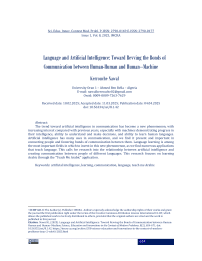Language and Artificial Intelligence: Toward Revving the Bonds of Communication between Human-Human and Human‒Machine
Автор: Kerrouche Nawal
Журнал: Science, Education and Innovations in the Context of Modern Problems @imcra
Статья в выпуске: 1 vol.8, 2025 года.
Бесплатный доступ
The trend toward artificial intelligence in communication has become a new phenomenon, with increasing interest compared with previous years, especially with machines demonstrating progress in their intelligence, ability to understand and make decisions, and ability to learn human languages. Artificial intelligence has many uses in communication, and we find it present and important in connecting people and fostering bonds of communication between them. Language learning is among the most important fields in which to invest in this new phenomenon, as we find numerous applications that teach language. This calls for research into the relationship between artificial intelligence and creating communication between people of different languages. This research focuses on learning Arabic through the "Teach Me Arabic" application.
Artificial intelligence, learning, communication, language, teach me Arabic
Короткий адрес: https://sciup.org/16010349
IDR: 16010349 | DOI: 10.56334/sei/8.1.42
Текст научной статьи Language and Artificial Intelligence: Toward Revving the Bonds of Communication between Human-Human and Human‒Machine
The global society has experienced different historical eras, progressing from feudalism to industrialization and then to the information society, where information defines its essence and character. On the basis of McLuhan's theory, technological determinism has not only placed societies in the information age. However, it has also aimed to create intelligent machines and concise applications that can ease life and overcome challenges for individuals and institutions alike, with the ultimate goal of achieving communication, which is the demand of the people and the highest aim of life. Artificial intelligence is considered one of the most recent manifestations of the information revolution, which has drawn parallels between artificial intelligence and human intelligence to simulate humans and create machines capable of learning and understanding. This led to the emergence of the digital space, which has introduced numerous innovative applications that operate according to artificial intelligence algorithms. In this context, individuals face various applications that enable them to learn any language with minimal cost and effort, highlighting the difficulties in achieving communication with others who are different from the self.
The "Teach Me Arabic" application is an AI-supported application that teaches the Arabic language to nonnative speakers.
Through this research paper, we aim to highlight the importance of artificial intelligence in facilitating communication between humans and machines. The "Teach Me Arabic" application serves as a model for language learning applications, and we analyse it to demonstrate the significance of AI-powered applications in connecting people for cooperation and mutual understanding, especially in light of globalization and the open digital space that connects humans and machines.
Research Problem
How can the artificial intelligence application "Teach Me Arabic" foster communication between humans and between humans and machines?
Research Objectives
This paper aims to:
-
> The role of artificial intelligence in enhancing communication between nations and building a communication relationship between humans and machines is highlighted.
-
> This study demonstrates the importance of Ai-supported applications in the field of language learning.
-
> Guide the reader on how to use artificial intelligence in language learning applications to address communication challenges with others, especially in light of global openness to the 'other'.
Methodology and Sample
Issue 1, Vol. 8, 2025, IMCRA
Since our study is qualitative, the analytical approach based on description is the most appropriate. Our sample consists of the "Teach Me Arabic" application.
Introduction to artificial intelligence
1/Definition of artificial intelligence:
There have been numerous definitions of artificial intelligence; among the most notable are the following:
Brien O defined it as "a science and technology based on several cognitive fields such as computer science, mathematics, biology, philosophy, and engineering, aiming to develop computer functions to mimic human intelligence. "2 Similarly, Levin et al. defined it as "the way in which a computer becomes capable of thinking intelligently."
Rolston defined artificial intelligence as "computer-based solutions to the most complex problems through practical processes that resemble human reasoning." Richer and Naghit also stated that artificial intelligence is "the behaviour of a machine that, if done by a human, would be called intelligent."
In general, it is the creation of machines that perform tasks that require intelligence when performed by humans. It is the study of how to make computers perform tasks that humans can do better. It is also defined as "the branch of computer science that enables the creation and design of computer programs that mimic human intelligence, allowing computers to perform certain tasks on behalf of humans, which require thinking, understanding, hearing, speaking, and movement in a logical and organized manner. "3 In the same stream, "It is the simulation of human intelligence and understanding its nature through the creation of computer programs capable of mimicking human behavior characterized by intelligence. "4 In general, artificial intelligence can be defined as "a set of efforts aimed at developing computerized information systems in a way that allows them to act and think in a manner similar to humans. These systems can learn natural languages and perform practical tasks in a coordinated manner or use images and cognitive forms to guide physical behaviour. At the same time, they can store accumulated human experiences and knowledge and use them in the decision-making process. "5
-
2 Asalah Raqiq, The Use of Artificial Intelligence Applications in Managing Organizational Activities: A Case Study of a Group of Economic Institutions , Supplementary Thesis for the Master’s Degree in Management Sciences, University of Oum El Bouaghi, Faculty of Economic Sciences, Commercial Sciences, and Management Sciences, 2014-2015, pp. 12, 14.
-
3 Ahmed Kazem, Artificial Intelligence , Department of Programming, Faculty of Information Technology, Imam Jaafar Al-Sadiq University, 2012, p. 2.
-
4 Ahmed Kazem, Ibid. , p. 2.
-
5 Abubakr Khawald, Applications of Artificial Intelligence as a Modern Approach to Enhancing the Competitiveness of Business Organizations , Democratic Centre for Strategic, Political, and Economic Studies, Berlin, Germany, 2019, p. 13.

Issue 1, Vol. 8, 2025, IMCRA
2/Characteristics of artificial intelligence:6
Artificial intelligence possesses several characteristics and features, including the following:
-
• The use of intelligence to solve problems with incomplete information.
-
• The ability to think and perceive.
-
• The ability to acquire knowledge and apply it.
-
• The ability to learn and understand from past experiences and trials.
-
• The ability to use previous experiences and apply them to new situations.
-
• The ability to use trial and error to explore different matters.
-
• The ability to respond quickly to new situations and conditions.
-
• The ability to handle complex and challenging cases.
-
• The ability to address ambiguous situations in the absence of information.
-
• The ability to distinguish the relative importance of elements in a given situation.
-
• The ability to visualize, create, and understand visual matters.
-
• The ability to provide information to support decision-making processes.
3/Relationships between Human Intelligence and Artificial Intelligence:
The contribution of artificial intelligence to understanding human intelligence is one of the most important links between the two. On the one hand, understanding human intelligence, including processes such as perception, memory, and language, improves the ability of researchers in the field of artificial intelligence to create artificial means—machines capable of performing these processes. On the other hand, developing artificial intelligence research enhances psychologists' ability to understand human thinking and intelligence. The relationship between them becomes evident through the transfer and simulation of human intelligence in the form of programs and systems that enable computers to address areas that require intelligence when attempting to find solutions. The relationship between them becomes clearer through the following:
-
❖ Programs and systems have been developed to recognize, understand, and process natural languages, simulating some aspects of human intelligence, such as auditory perception, understanding, and speech. Computers can now understand natural languages such as English and Japanese and perform machine translation from one language to another.
-
❖ Simulating the control of the brain and senses over motor functions: Programs and robotic systems have been developed in robotics and linguistics to replicate fine motor control and decisionmaking related to movement for practical use.
Issue 1, Vol. 8, 2025, IMCRA
-
❖ Creating models to simulate the functioning of neurons in the brain by developing models that mimic human brain behaviour and advancing mathematical modelling to simulate perceptual behaviours. This also includes the development of learning theories and simulating parallel processing methods.
-
❖ The development of neural networks and neural computing has evolved to simulate human recognition and learning, an attempt to replicate the methods used by the human brain.7
History of artificial intelligence:
Artificial intelligence is the result of 2000 years of philosophical traditions and theories of perception and learning, along with 400 years of mathematics that led to the development of logic, probability, and computation theories. It also has a rich history in the development of psychology, which has revealed the capabilities and workings of the human brain. It is also the product of efforts in linguistics that uncovered the structure and meaning of language and the evolution of computer science and its applications.
The philosophical roots of artificial intelligence trace back to ancient Greek philosophers such as Socrates, Aristotle, and Plato, as well as to the French philosophers Francis Bacon and Bertrand Russell, who introduced the concept of logical positivism.8 These philosophers attempted to study various topics related to this concept, such as vision, learning, memory, and rationality, and some even questioned the possibility of artificially creating these phenomena. Historical records from the Greeks and ancient Egyptians provide evidence of an early fascination with creating intelligent machines that mimic human behaviour. This long-standing human interest in understanding the nature of intelligence and the potential for creating it is evident throughout history.
Artificial intelligence also traces its roots to mathematics through three areas in computing, namely, computation, logic, and probability theory, as well as algebra, which was founded by the Arab scholar Al-Khwarizmi.9 In the mid-20th century, a small group of scientists began exploring a new approach to building intelligent machines on the basis of recent discoveries in neuroscience, new mathematical theories of information, the development of automatic control theory, and, most importantly, the invention of the digital computer. Additionally, a machine was invented that could simulate human computational thinking.10 In the 16th century, the clock machine and the first mechanical moving animal were invented, followed by many similar moving machines.11
Issue 1, Vol. 8, 2025, IMCRA
In general, the history of the development of artificial intelligence can be divided into the following historical stages:12
1/First Stage:
The first stage emerged shortly after the end of World War II, beginning with the work of the scientist Shannon in 1950, who researched the game of chess and concluded with the work of Fidgen Baum and Field Man in 1960.
This first stage was characterized by finding solutions to games and solving puzzles via computers, which relied on developing search methods in spatial representation that represent the initial state. This led to the development of modelling and the introduction of computational models based on three factors:
-
• Representing the initial state of the subject under investigation (such as the chessboard before starting the game).
-
• The conditions for perceiving the end state (i.e., defeating the opponent) are chosen.
-
• The rules govern the player's movement by moving chess pieces on the board.
A diagram can be created for these factors in space, where the states are represented as "nodes" and the operations as "arcs." Thus, the spatial representation between the nodes and arcs increases as the game progresses, as seen in the case of chess.
2/Second Stage:
This stage, known as the "romantic" stage, began in the mid-1960s and lasted until the mid-1970s. During this period, the scientist "Minsky" created frameworks ("frapes") to represent information, and "Wengerad" developed a system for understanding English sentences, such as stories and conversations.
The scientists "Winston" and "Brown" summarized all that had been developed at the Massachusetts Institute of Technology (MIT), which included research on natural language processing, computer vision, human‒robot interaction, and symbolic and formal processing.
3/Third Stage:
This stage is known as the modern stage, which began in the mid-1970s and was marked by the emergence of various techniques that address many applications. This led to the transfer of a significant portion of human intelligence to computer programs, which is considered the golden age for the flourishing of this science. This led to the development of many modern artificial intelligence systems.
Sci. Educ. Innov. Context Mod. Probl. P-ISSN: 2790-0169 E-ISSN: 2790-0177 Issue 1, Vol. 8, 2025, IMCRA
The core techniques of artificial intelligence began to take shape, encompassing symbolic modelling, list processing mechanisms, and various programming techniques. These innovations interact with many branches of science.
4/The Modern Era and the Emergence of ChatGPT:
This is an advanced stage of artificial intelligence known as generative artificial intelligence. It is a technology that allows organizations to create AI models that can be used to solve business problems. The goal is to improve various business processes, including faster production and dissemination of content, enhancing the user experience, improving production processes, increasing productivity, and enhancing output accuracy, in addition to reducing costs.
This application caused a significant stir globally and gained widespread fame shortly after its launch, with nearly one million users within the first five days of its release in late November 2022.
ChatGPT is one of the latest techniques in natural language processing. Its integration with a large dataset and advanced processing capabilities allow it to improve chatbot systems and provide an efficient user experience.13
Applications of artificial intelligence in education and learning:
1/Applications of artificial intelligence and its domains:14
-
• Expert systems: These systems provide the computer with vast amounts of information known as human expertise in a specific field or speciality, enabling it to perform tasks only by experts in that domain.
-
• Speech recognition: These programs can convert spoken words into written text.
-
• Natural Language Processing (NLP): These programs feed the computer with natural languages to receive commands directly in those languages, enabling it to interact and converse with people naturally and easily.
-
• Speech Synthesis: These programs can convert written words into spoken sounds.
-
• Games: Artificial intelligence has contributed to the development of games, making them more realistic.
-
• Handwriting recognition: These programs can translate handwritten words into digital text on a computer.
Issue 1, Vol. 8, 2025, IMCRA
-
• Robots: Known as humanoid robots, these machines are connected to a computer that controls them, allowing them to perform specific tasks. Artificial intelligence has enabled robots to move, understand their surroundings, respond to commands, and carry out work.
-
• Pattern and Shape Recognition and Comparison: This includes recognizing and comparing features such as fingerprints, eyes, and faces.
-
• Vision: The computer is equipped with optical sensors that allow it to recognize the identities of individuals.
-
• Decision Support: These programs provide various alternatives, gather information, and guide the computer in making decisions.
-
• Summarization: These programs summarize written, audio, and visual news content.
-
• Education: Artificial intelligence is used in education, with various programs and applications designed to increase student engagement with the curriculum and enhance student understanding.15
2/How to Apply Artificial Intelligence in Education:16
Artificial intelligence plays a crucial role in the educational process by offering technologies that integrate various presentation media, such as text, audio, and static and dynamic images. This integration enhances the learning experience, making it more interactive, personalized, and efficient.
First - Intelligent Content:
This involves converting book content into digital formats or guides for publication across all educational stages, from primary to secondary, on digital learning platforms. Artificial intelligence is used to automate business processes and distribute textbook content through an intelligent study guide. This includes lesson summaries and multiple-choice tests, where specific text summaries for each part or chapter are presented and then archived into a digital collection, making them available on digital learning platforms.
Second - Intelligent lesson systems:
In the late 1970s, the educational psychologist Benjamin Bloom identified a set of principles closely related to the effectiveness of individualized teaching. These principles involve organizing and delivering the curriculum according to the progress of each student and learner in general, utilizing timely feedback, and implementing reinforcement activities, which are fundamental learning practices during the classroom process. The application of artificial intelligence in individualized education systems can provide these elements, enhancing the learning experience by personalizing it to suit each student's pace and needs.
Issue 1, Vol. 8, 2025, IMCRA
Third - Virtual assistants and learning environments:
Studies have shown no desire to replace human teachers with virtual teachers. However, the actual and ultimate goal of creating virtual interfaces and using them in diverse educational environments is to create human-like characters that can think and interact naturally, understanding commands through verbal and nonverbal communication. These virtual assistants can enhance the learning experience by providing interactive and dynamic educational support.
3/"Teach Me Arabic" application: A Model
-
• The Arabic Language: Concept and Status

Teach Me Arabic
Definition of the Arabic Language:
Linguistically, language consists of sounds through which everyone expresses their intentions. It is an action, as in the verb "to speak," and its origin is "lugwah," meaning the abundance and scarcity of speech. It is also said to come from "laghwa" or "lugho. "17
In his work Al-Haqa'iq, Ibn Jinni defines language as "it is the sounds through which every group of people expresses their intentions. "18
In his Muqaddimah , Ibn Khaldun defines language as "an acquired mental ability represented by a system composed of spoken symbolic signs through which individuals of a particular society communicate. "19
The Status of the Arabic Language in Ancient Times:
Arabic was a prestigious language in ancient times, mainly due to its connection with religious factors. Its spread was closely linked to the Islamic call in the Arabian Peninsula, and it gained significant attention, particularly with respect to the Quran. Learning Arabic became necessary for understanding Islam's principles, grasping its teachings, and applying them.
The spread of the Arabic language among Arab and Islamic peoples elevated its status. Anyone seeking civilization and religion had to teach it, increasing the language demand.
Issue 1, Vol. 8, 2025, IMCRA
The Arabic language has a rich history both in East China and West China. The sciences and philosophy of the Arab world attracted Europe, which witnessed numerous scholars who dedicated their lives to learning Arabic to understand Arab civilization.20
The Arabic Language in Modern Times:
Modern Standard Arabic is considered the unifying language for Arabs; it is a key link that brings together the peoples of the Arab and Islamic worlds. Language and religion are two sides of the same coin.
One of the main challenges the Arabic language faces today is the dominance of colloquial dialects, which have overtaken the use of Standard Arabic, even among educated individuals and in educational institutions. This presents a significant issue that must be addressed to maintain the prestigious status of the Arabic language as it once had.
In the age of globalization, Arabic is no longer the language of science and philosophy. Its status has declined with the rise of English and other foreign languages that convey science, literature, and philosophy. This decline may be attributed to the fascination of Arab societies with all things foreign and a sense of inferiority in their native language, leading to its decline in the era of globalization.21
-
• Presentation of the "Teach Me Arabic" application:
Definition:
The "Teach Me Arabic" application is designed to teach the Arabic language quickly and effectively. It aims to teach Arabic to nonnative speakers via smartphone applications through the most advanced self-learning method, with supervision from a specialized academic team.
The application contains many interactive activities, live sessions, and accurately applied assessment tests. It also features a rich library of audio and visual clips, educational graphics, and educational stories.
It also includes:
Interactive Activities:
It is designed to help you learn and practice all language skills, including listening, reading, writing, and speaking. Hundreds of game-based activities have been designed and included, using various activity models such as multiple choice, yes/no questions, fill-in-the-blanks, sentence rearrangement, and column matching.
Issue 1, Vol. 8, 2025, IMCRA
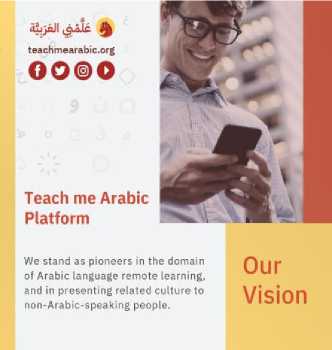
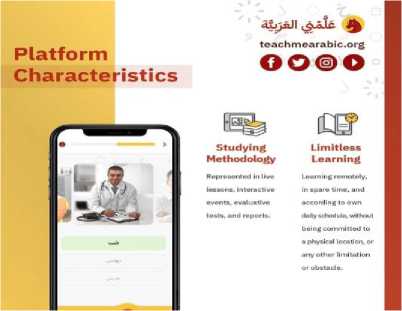
Educational Content:
It includes many live videos, audio recordings, and educational graphic designs. Despite the advanced production techniques, the content is built from a certified curriculum by a qualified and specialized academic committee.
Let us talk:
This is a practical environment where you can enhance and practice your knowledge and skills in a live virtual café supervised and trained by native-speaking teachers. At any time, you can join a live session available 24 hours a day for intensive interaction with other peers under systematic supervision.
Unrestricted Learning:
You can fully use your free time to learn the language without restrictions.
It was created on April 25, 2021, and is available on the Play Store with the following information:
Version: 2.1.0
Download size: 23.48 MB
Downloads: More than 100,000

Issue 1, Vol. 8, 2025, IMCRA
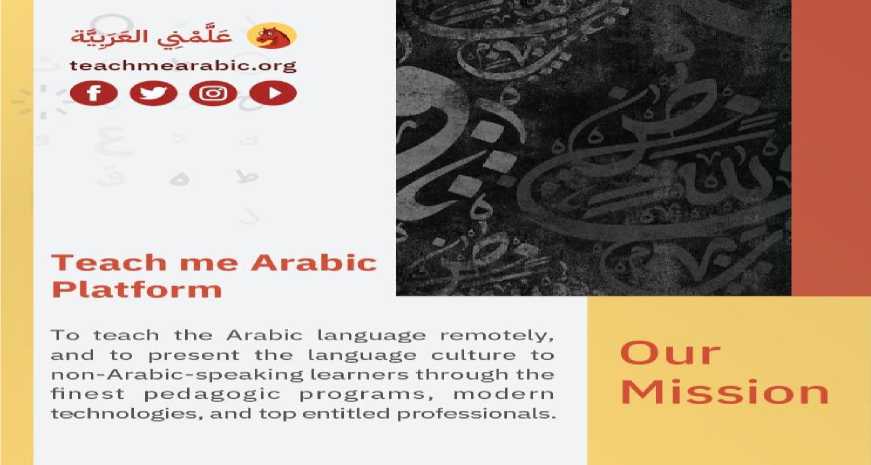
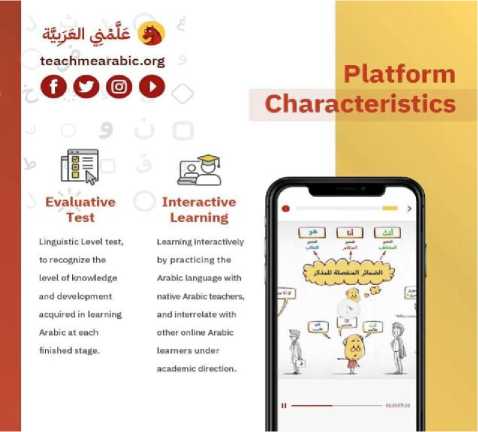
Issue 1, Vol. 8, 2025, IMCRA
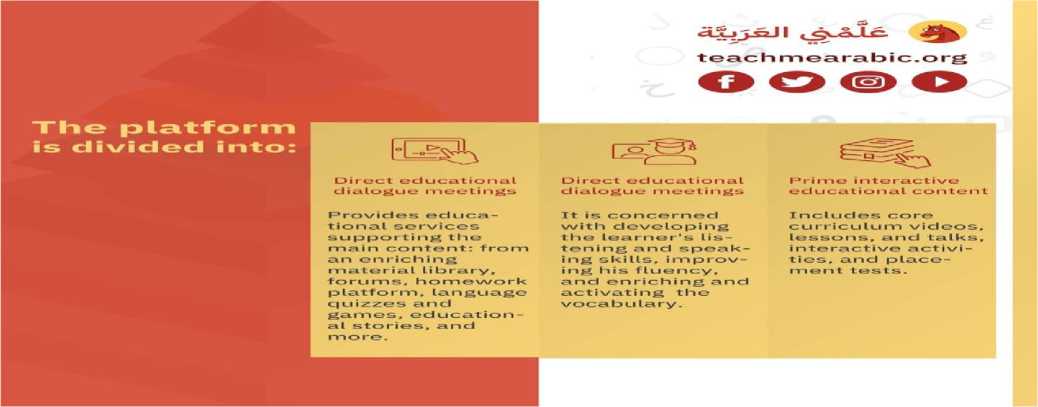
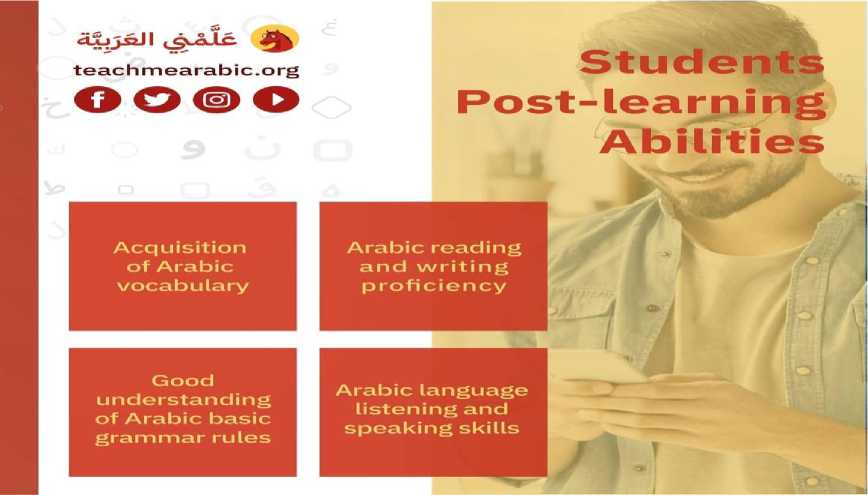
Issue 1, Vol. 8, 2025, IMCRA
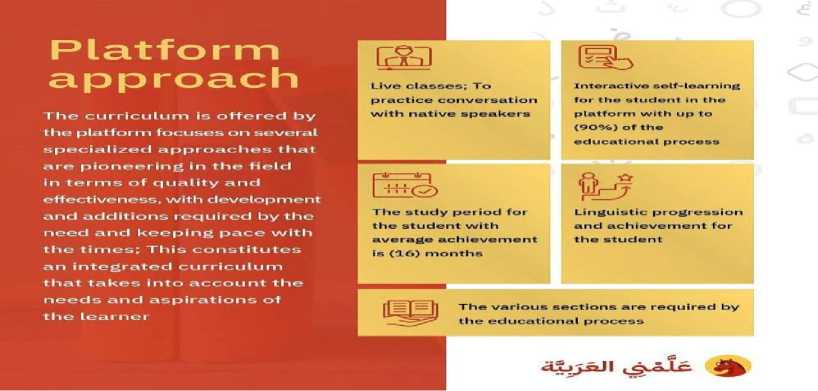
The Learning Environment of the "Teach Me Arabic" Application:
Table 1: Application Components
|
Teach Me Arabic Application Components |
Analysis |
|
Objectives |
The platform's goals are clear: to enable learners to acquire skills and knowledge about the Arabic language to expand its usage. |
|
Activities and Exercises |
Individual Activities: Through self-learning, the learner acquires skills through personal experience on the platform. Group Activities: Learners collaborate through communication and interaction. Synchronous Activities: Through sessions programmed by teachers via remote interaction applications at a specific time. Asynchronous Activities: Through learning without restrictions, which is a core part of the platform's methodology. |
|
Content |
The platform contains levels, each divided into units, and each unit has a set of lessons. This ensures logical progression in learning based on language rules and fundamentals, especially since each level ends with a test to move on to the next level . |
Issue 1, Vol. 8, 2025, IMCRA
|
Group Learning |
The application allows the learner to choose between individual and group learning. The latter allows learners to correct mistakes and motivate each other. |
|
Communication and Interactivity |
Interactive activities through videos and cooperative learning based on a structured methodology under the guidance of Arabic language teachers. |
|
Feedback and Reports |
There is immediate feedback through the learner's progression to higher levels as they pass the tests for each level, transitioning to more advanced levels and deeper content. |
|
Technologies |
Videos, stories, conversations, and remote sessions allow learners to practice conversation with specialized Arabic language teachers, focusing on the educational strategy of 'spaced repetition.' |
Table 2: Pedagogy of the Lessons on the "Teach Me Arabic" platform
|
Component |
Analysis |
|
Level |
There are eight levels, each containing four units, and each unit has between 86 and 97 lessons. |
|
Interface |
The interface provides the learner's report and allows them to choose between selflearning or group learning. |
|
Content |
The contents are similar across levels, with each level including letters, words, sentences, and conversations. The difficulty increases at higher levels. |
|
Educational Actions |
Choose the unit, choose the lesson, select the image, listen, and speak. |
From the tables above, it is clear that the "Teach Me Arabic" application focuses on the following:
J- Language Rules: Through teaching the learner the basics of grammar and morphology.
-
4- Enhancing Listening Skills: By using images accompanied by sound and sentences.
-
4- Enhancing Reading Skills: Using images paired with sentences.
А Enhancing expression skills: The learner must select the image that matches the words or sentences by providing multiple images with corresponding words or correct sentences. Additionally, the microphone can be turned on to speak during videos.
Issue 1, Vol. 8, 2025, IMCRA
This allows us to say that the platform enhances many skills in the learner's educational methodology, such as the audiovisual method and the gradual approach to acquiring knowledge and skills, especially when the content is linked with context.
-
^ The platform also relies on gamification by creating a challenge for the learner, making the learning process resemble digital games. This enhances the learner's desire to progress to higher levels, thus allowing him or her to acquire new skills according to the content of the higher level.
Manifestations of artificial intelligence in the "Teach Me Arabic" application:
The presence of artificial intelligence on this platform is evident in its methodology, with manifestations linked to pedagogical scenarios as follows:
^ Intelligent content
^ Embedding the Arabic language and its rules into a digital platform ("Teach Me Arabic Platform and App") enables nonnative speakers to learn the language independently of time and place. This is achieved through scientific teaching automation and making it accessible on the platform and application.
^ The application combines multimedia elements ("images, text, videos, sounds") to enhance comprehension.
^ Intelligent Lessons:
^ "Teach Me Arabic" focuses on a learning methodology that is based on the learner's progress. This method involves self-learning through the levels included in the app ("8 levels").
^ This is one of the features of artificial intelligence in self-learning.
^ Virtual assistants:
^ Through verbal and nonverbal communication, the application becomes an alternative to a human teacher, demonstrating the presence of artificial intelligence or the machine itself.
The teaching strategies that showcase the manifestations of artificial intelligence are as follows:
^ Spaced Repetition Strategy:
^ This educational method involves reviewing concepts at increasing intervals over time. Through strategically spaced vocabulary exercises and their repetition at set time intervals, the AI-generated content ensures that learners revisit and reinforce the previously learned words, improving retention and recall.
^ Logistic Regression:
^ The "Teach Me Arabic" app allows learners to choose another option after providing an incorrect answer. It also allows the teacher to assess the learner's level and intervene to correct mistakes.
Issue 1, Vol. 8, 2025, IMCRA
^ The app presents lessons in an easy and organized manner.
^ Machine Learning:
^ The machine can learn natural language and identify errors by integrating artificial and human intelligence in the "Teach Me Arabic" application. This enables the system to be prepared to interact with humans in the semantic web.
Results of the Study:
Our study on the "Teach Me Arabic" application led to the following results:
-
• The "Teach Me Arabic" application enhances the learning and development of the Arabic language by integrating computer systems, language, and machine intelligence, creating a stimulating educational environment for nonnative speakers.
-
• Artificial intelligence in education, particularly in languages, facilitates language learning without time and space constraints.
-
• The integration of the "Teach Me Arabic" application with artificial intelligence technologies can accelerate the learning of the Arabic language on two levels:
-
o Human Level: Through the content provided by the application, which integrates multimedia, where AI serves human intelligence in the field of language learning.
o Machine Level: This is known as machine learning, where the interaction between the learner and the "Teach Me Arabic" application enables artificial intelligence to learn the language, making the machine capable of understanding Arabic in the future semantic web (Web 3.0).
Conclusion:
Our era requires us to keep up with technological advancements and revolutions. Education is no longer bound by the traditional requirement of having the teacher and student present in the same environment or location. Instead, artificial intelligence-created applications have become a breath of fresh air and an alternative to traditional methods. The learning process has become simpler and more enriching through the integration of various media, which helps overcome the challenges that learners face.
The "Teach Me Arabic" application is a platform dedicated to teaching Arabic to nonnative speakers. As previously mentioned, it leverages artificial intelligence to contribute to the development and growth of the Arabic language in the context of globalization while teaching the machine Arabic. This leads us to conclude that, owing to artificial intelligence; the Arabic language can grow and expand its usage in the enhanced digital environment.

